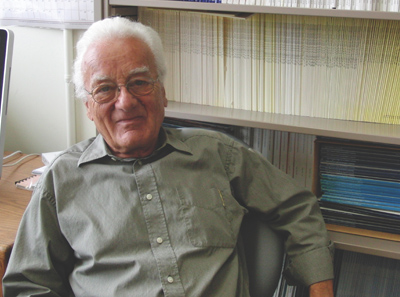Profile of Distinction: Petar Kokotovic

An Interview with Petar Kokotovic
Professor Emeritus, ECE, UCSB
Interviewed for the Fall 2012 ECE Current newsletter
- UCSB Years: 1991-present
- Awards: National Academy of Engineering (1996), Foreign Member of the Russian Academy of Sciences (2011), IEEE Life Fellow (1980), IFAC Fellow (2005), IEEE James H. Mulligan Jr. Education Medal (2002), AACC Richard E. Bellman Control Heritage Award (2002)
Career Highlights:
- Kokotovic developed the sensitivity points method, a precursor to adaptive control, still in use for automatic tuning of industrial controllers.
- In the 1970s, he pioneered singular perturbation techniques for multi-time-scale design of control systems and flight trajectories.
- As a long-term industrial consultant, Kokotovic contributed to the design of the first computer controls for car engines at Ford, and to power system stability analysis at General Electric.
 Video of Interview with Petar Kokotovic
Video of Interview with Petar Kokotovic
Professor Emeritus Petar Kokotovic joined the ECE department in 1991. He helped form and went on to direct until 2003 what is now the Center for Control, Dynamical Systems, and Computation. His research focused on nonlinear control, both robust and adaptive. He initiated the development of a popular nonlinear recursive design, backstepping, and is one of the highly cited authors in his field and in engineering. Known for his passion for mentoring, he has supervised 35 Ph.D. students and 20 postdoctoral researchers, with whom he co-authored numerous papers and ten books.
What are the biggest changes you have seen in the past 20 years in the ECE department?
There has been a whole change of generations. We have a tremendous group of super talented young faculty. I think it’s exciting how new, young, and accomplished the department is now. Those who I call young are my colleagues in their 40s and 50s who have accomplished a lot. The number of recognitions that have come to the department in the forms of memberships to national academies, societies, and awards, and the crop of graduate students and their careers greatly benefit the department.
Can you tell us about founding the CCDC (formerly CCEC) and its beginnings?
My formal appointment was April 1, 1991 and the center had already been formed. The initial plan was to take over the building that was still available through the college from a different federally funded center of robotics, but I didn’t want to do that. I was in favor of sharing interests, and I felt that having a joint seminar was much more important, so we created that. Instead of teaching separate courses in chemical engineering, mechanical engineering, and electrical engineering, we put it all together so that the graduate students came from all different departments. Our classes became bigger and we were able to offer much more diversity of courses with the same number of faculty.
What accomplishments within the center are you most proud of?
Primarily, the success of the students and the growth of young faculty who have become national and international stars. It’s pretty amazing how successful they are and how well-known they are. A group of 14-15 faculty with about 60-70 graduate students, many of whom have accomplished a lot and have wonderful positions in both industry and academics. This is a great outcome, and the many awards people have received and the many distinctions, and invitations to give lectures show this. I think this is very much unique in the center.
You have served on (and chaired) numerous PhD and MS committees. Are there any particular success stories you’d like to share?
I would say that success stories are due to the students themselves. Very often there comes extraordinary talent, and all the credit goes to the mentor. I remember two or three of my students, hard working, and wonderful young men. They were initially so insecure, but wow, what a success they were! The key is to encourage their hidden abilities and allow them to surface. I myself had the three most remarkable mentors one can imagine. You feel like family with them. Basically to the end of their lives, I remained in contact. So it goes way beyond the relationship as a mentor and mentee. I once wrote a little autobiographical sketch that the whole nature of research can lead to an introverted genius sitting somewhere doing research alone, but it’s so much more fun to do research together – to have it as a social activity; to have the fulfillment to see other people succeed or help you succeed.
How do you give back to the college (UCSB)?
In today’s climate, the state – well, education – it’s under attack, losing resources. I think we, as citizens, could do more and should do more, to apply political pressure to our representatives not to allow the impoverishment of higher education and education in general. The University of California system is a grand idea that has worked so well for so long. We have to save it and develop it, so my idea of giving back is getting engaged to prevent the destruction of the University of California system.